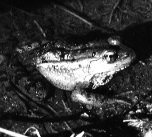 Photo courtesy of the Sierra Club
Photo courtesy of the Sierra Club
 Photo courtesy of the Sierra Club
Photo courtesy of the Sierra Club
The California red-legged frog, a candidate for protection under the federal Endangered Species Act, has been documented living in the route of the proposed Devil's Slide bypass, posing yet another obstacle to its construction.
The frog's existence on Shamrock Ranch south of Pacifica was first discovered by members of the Sierra Club. Ed Pang, senior environmental planner for the California Department of Transportation, said a biologist hired by CalTrans recently confirmed the discovery.
Meanwhile, the nine-year-old litigation over the bypass continues to drag on. Attorneys for the Sierra Club and CalTrans spoke by phone last week with U.S. District Court Judge Lowell Jensen. The earliest a ruling removing the injunction imposed against the bypass could come down is 60 days, a CalTrans spokesman said, although he acknowledged that no action is likely before "the end of the year."
What the discovery of the red-legged frog means for the long-delayed road is uncertain, like the future of the frog. The frog was proposed for addition to the Endangered Species list and a decision was supposed to have been made by February, but the U.S. Fish and Wildlife Service missed that deadline.
Since then, Congress has enacted a moratorium on new additions. But a judge told Fish and Wildlife officials to proceed with its decision by Sept. 15 since it was due prior to enactment of the moratorium.
Even though it is not yet on the list, the frog's discovery requires CalTrans to confer with Fish and Wildlife over how to prevent or minimize the impact upon the animal, according to Alison Willy, Fish and Wildlife biologist. Solutions could range from simply relocating the pond where the frogs live to rerouting the bypass, she said.
CalTrans has yet to initiate discussions, Willy said. The frog was only recently discovered, although CalTrans spokesman Greg Bayol said Monday that " . . . we've known about the frog for a few years."
Pang said studies are currently being conducted by biologist Sam McGinniss to determine whether the endangered San Francisco garter snake also lives along the route of the highway. The red-legged frog is a primary food source for the snake, but Pang said he did not think the snake had been found there in the past.
The study is part of a "re-evaluation" by CalTrans of the nine-year-old environmental impact report originally prepared for the bypass.
Peter Drekmeier, spokesman for the Sierra Club Devil's Slide Campaign, said the red-legged frog is proof that the EIR is "stale" and needs a complete update, including new public hearings. Hearings are not required for a re-evaluation.
He said new information is needed regarding the possible existence of steelhead trout in San Pedro Creek, flooding in Willowbrook Estates in Pacifica, runoff into the Monterey Bay National Marine Sanctuary and improvements in tunnel-building technology.
Willy and Connie Rutherford, a Fish and Wildlife plant ecologist, also said they had both heard that Hickman's Cinquefoil, a plant proposed for the Endangered Species list and thought extinct in San Mateo County, had been sighted in the Devil's Slide area, but the sighting has not been confirmed.
Bayol said the re-evaluation will sufficiently address any new environmental concerns, and should be completed by next summer.
Bayol accused the Sierra Club of using endangered species as a delaying tactic.
"There are people who do not want any road built," he said. "Any means that can be shown to delay the project, or at least give people a reason to oppose it, that's what they're going to do."
Meanwhile, Bayol said CalTrans is preparing a request for the injunction to be lifted. Once that is filed with Judge Jensen, the Sierra Club has 30 days to respond. CalTrans then has 30 days after that to respond to the Sierra Club.
Bayol said, however, that action on the injunction is unlikely before "the end of the year."